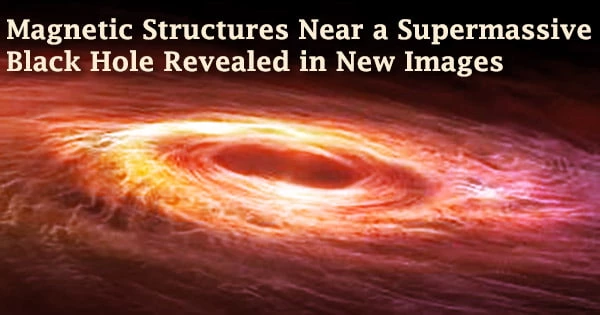A new image of the region closest to the supermassive black hole in the galaxy’s center, Messier 87 (M87), has revealed vital data about the magnetic fields near the black hole, as well as suggestions about how powerful material jets might emerge in that region.
The Event Horizon Telescope, a network of eight telescopes that includes the Atacama Large Millimeter/submillimeter Array (ALMA) in Chile, was used by a global team of astronomers to analyze a signature of magnetic fields termed polarization surrounding the black hole. The orientation of electric fields in light and radio waves is known as polarization, and it can reveal the existence and alignment of magnetic fields.
“We are now seeing the next crucial piece of evidence to understand how magnetic fields behave around black holes, and how activity in this very compact region of space can drive powerful jets,” said Monika Mo?cibrodzka, Coordinator of the EHT Polarimetry Working Group and Assistant Professor at Radboud University in the Netherlands.
Scientists were able to map magnetic field lines around the edge of M87’s black hole using new photos from the EHT and ALMA. In 2019, the EHT will photograph that same black hole for the first time. That photograph displayed a dazzling ring-like structure with a dark core section, which is the shadow of the black hole. The new photographs are crucial in understanding how M87, which is 50 million light-years away from Earth, is able to fire explosive jets from its core.

The newly published polarized images are key to understanding how the magnetic field allows the black hole to ‘eat’ matter and launch powerful jets.
Andrew Chael
The black hole at the heart of M87 is almost 6 billion times the mass of the Sun. The material pushed inside creates an accretion disk, a revolving disk that orbits the black hole closely. The majority of the material in the disk goes into the black hole, but some particles escape and are propelled into space in jets that travel at almost the speed of light.
“The newly published polarized images are key to understanding how the magnetic field allows the black hole to ‘eat’ matter and launch powerful jets,” said Andrew Chael, a NASA Hubble Fellow at the Princeton Center for Theoretical Science and the Princeton Gravity Initiative in the U.S.
The fresh photographs of the magnetic field configuration close beyond the black hole were compared to computer simulations based on several theoretical ideas. Only models with heavily magnetized gas can explain what scientists see near the event horizon, they discovered.
“The observations suggest that the magnetic fields at the black hole’s edge are strong enough to push back on the hot gas and help it resist gravity’s pull. Only the gas that slips through the field can spiral inwards to the event horizon,” explained Jason Dexter, Assistant Professor at the University of Colorado Boulder and Coordinator of the EHT Theory Working Group.
The scientists created a virtual Earth-sized telescope, the EHT, by connecting eight telescopes across the world, including ALMA, to make the new discoveries. The EHT’s outstanding resolution is comparable to that required to measure the length of a credit card on the Moon’s surface.
The team was able to see the black hole shadow and the ring of light around it up close, and the new image clearly shows that the ring is magnetic. The EHT group presented the findings in two pieces in the Astrophysical Journal Letters. More than 300 scholars from various organizations and institutions throughout the world participated in the study.
A third research, led by Ciriaco Goddi, a scientist at Radboud University and Leiden Observatory in the Netherlands, was also published in the same edition of the Astrophysical Journal Letters, based on ALMA data.
“The combined information from the EHT and ALMA allowed scientists to investigate the role of magnetic fields from the vicinity of the event horizon to far beyond the core of the galaxy, along its powerful jets extending thousands of light-years,” Goddi said.
The National Radio Astronomy Observatory is a National Science Foundation facility that is run by Associated Universities, Inc. under a cooperative agreement.
Over 300 scholars from Africa, Asia, Europe, North and South America are part of the EHT partnership. The multinational effort is developing a virtual Earth-sized telescope to collect the highest detailed black hole photos yet acquired.
The EHT is a completely new instrument with the highest angular resolving power ever obtained, thanks to significant international investment. It connects existing telescopes using unique techniques to create a fundamentally new instrument with the highest angular resolving power ever achieved.
The individual telescopes involved are: ALMA, APEX, the Institut de Radioastronomie Millimetrique (IRAM) 30-meter Telescope, the IRAM NOEMA Observatory, the James Clerk Maxwell Telescope (JCMT), the Large Millimeter Telescope (LMT), the Submillimeter Array (SMA), the Submillimeter Telescope (SMT), the South Pole Telescope (SPT), the Kitt Peak Telescope, and the Greenland Telescope (GLT).
The EHT consortium includes the Academia Sinica Institute of Astronomy and Astrophysics, the University of Arizona, the University of Chicago, the East Asian Observatory, Goethe-Universitaet Frankfurt, Institut de Radioastronomie Millimétrique, Large Millimeter Telescope, Max Planck Institute for Radio Astronomy, MIT Haystack Observatory, National Astronomical Observatory of Japan, Perimeter Institute for Theoretical Physics, Radboud University and the Smithsonian Astrophysical Observatory.
The Atacama Large Millimeter/submillimeter Array (ALMA), an international astronomy facility, is a partnership of ESO, the U.S. National Science Foundation (NSF), and the National Institutes of Natural Sciences (NINS) of Japan in cooperation with the Republic of Chile. ALMA is funded by ESO on behalf of its Member States, by NSF in cooperation with the National Research Council of Canada (NRC) and the Ministry of Science and Technology (MOST) and by NINS in cooperation with the Academia Sinica (AS) in Taiwan and the Korea Astronomy and Space Science Institute (KASI).
ESO leads ALMA construction and operations on behalf of its Member States; Associated Universities, Inc. (AUI) manages the National Radio Astronomy Observatory (NRAO) on behalf of North America; and the National Astronomical Observatory of Japan (NAOJ) on behalf of East Asia. ALMA’s construction, commissioning, and operation are all overseen by the Joint ALMA Observatory (JAO), which offers unified leadership and administration.
















